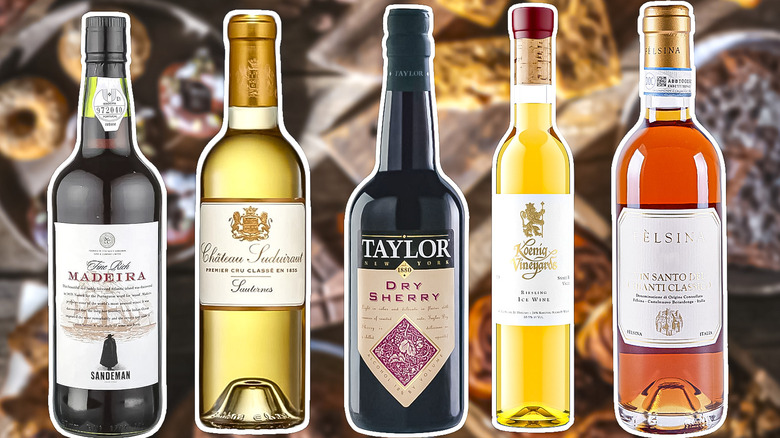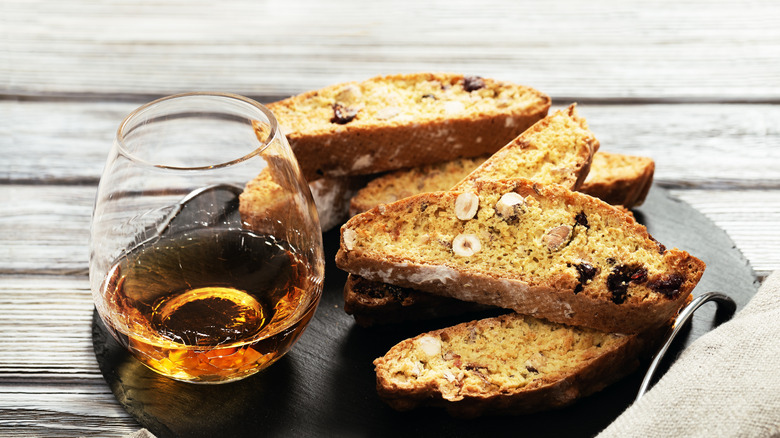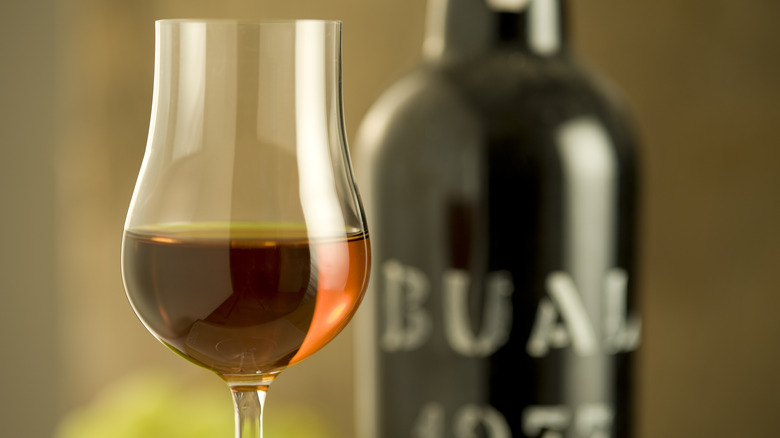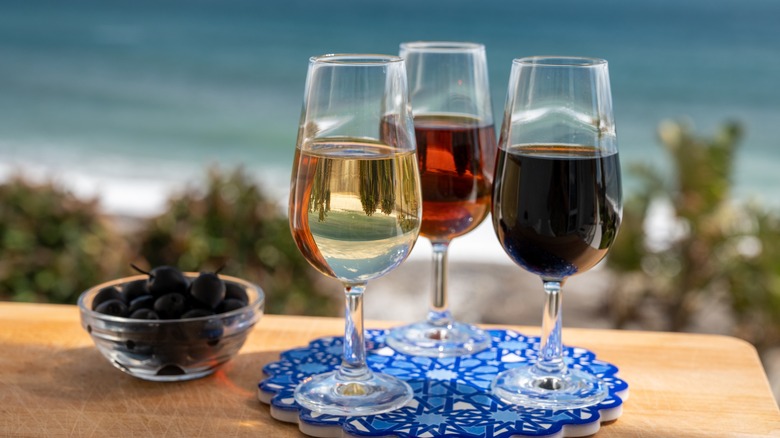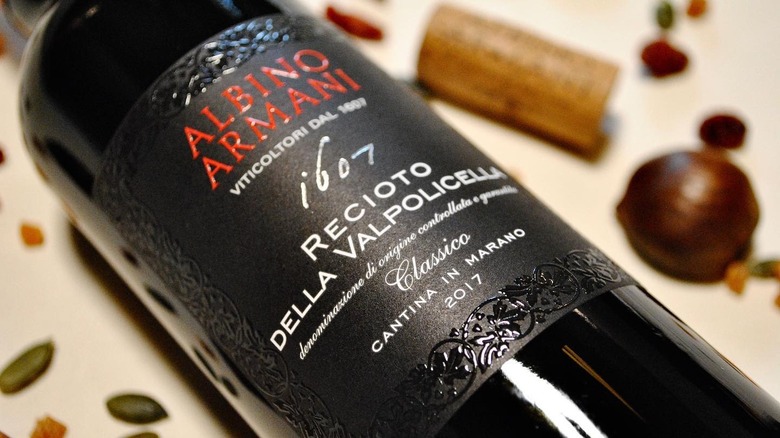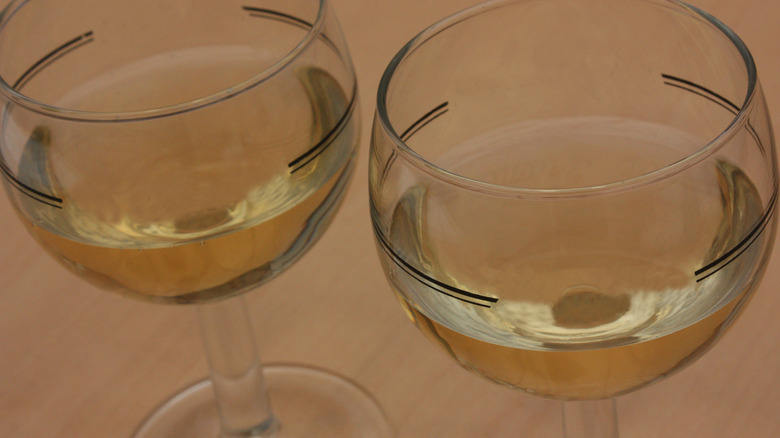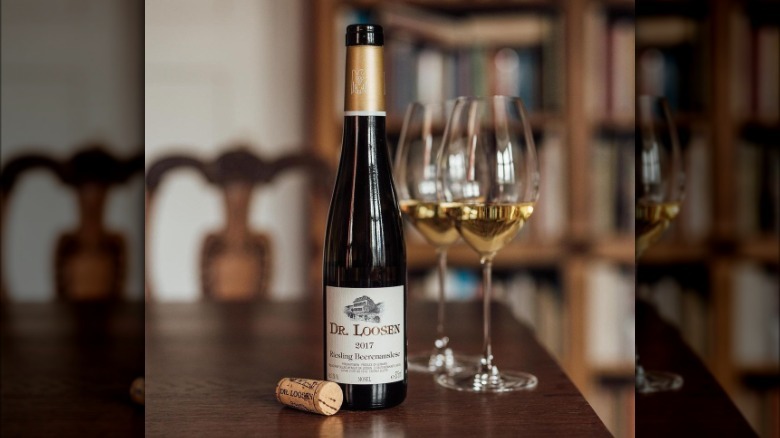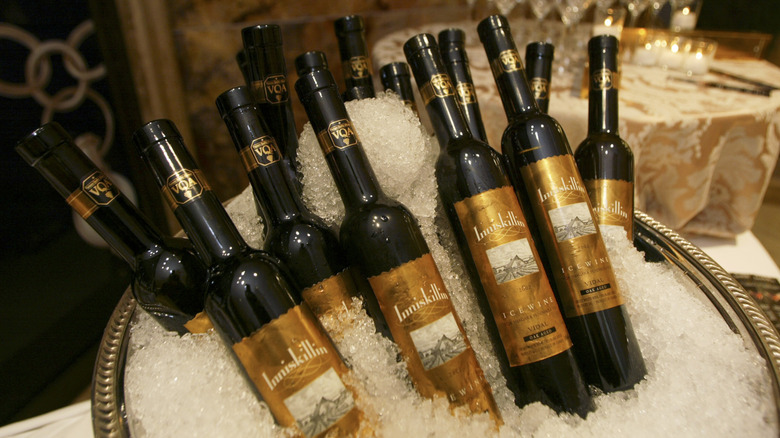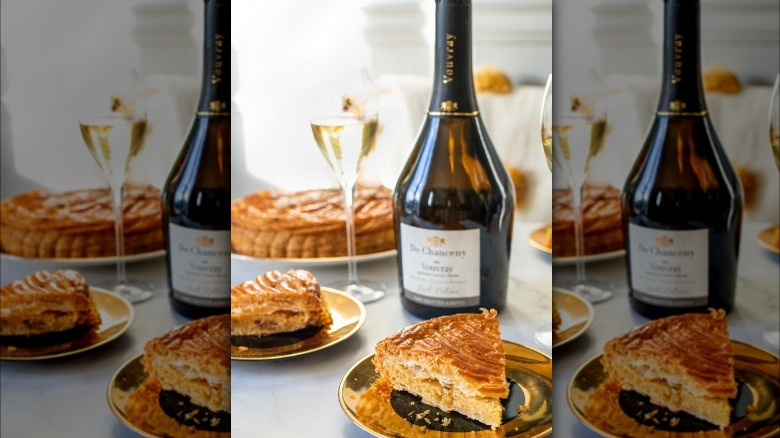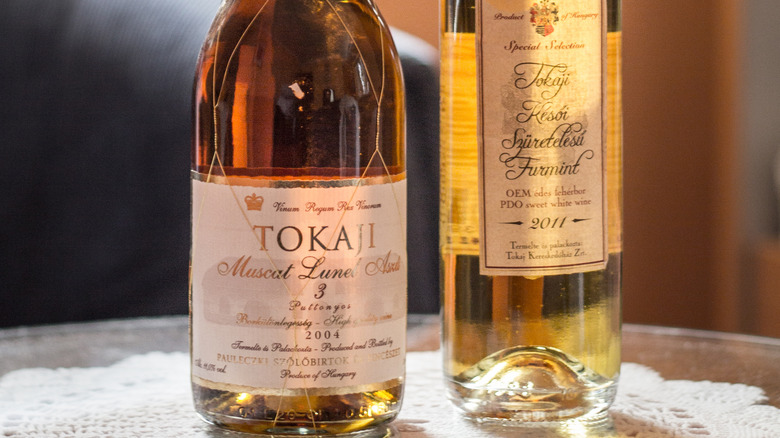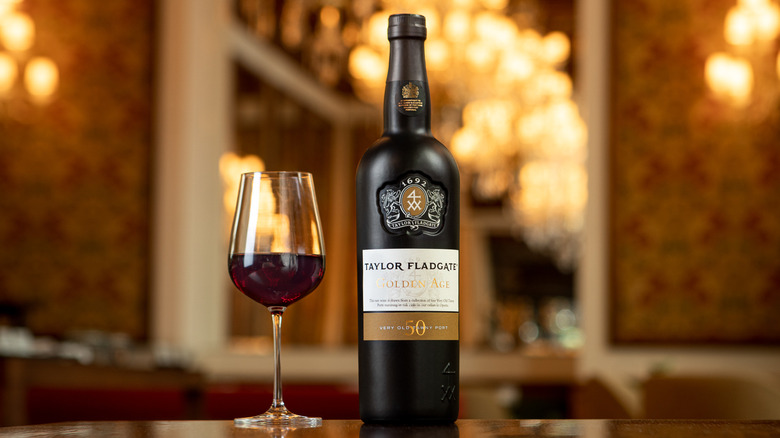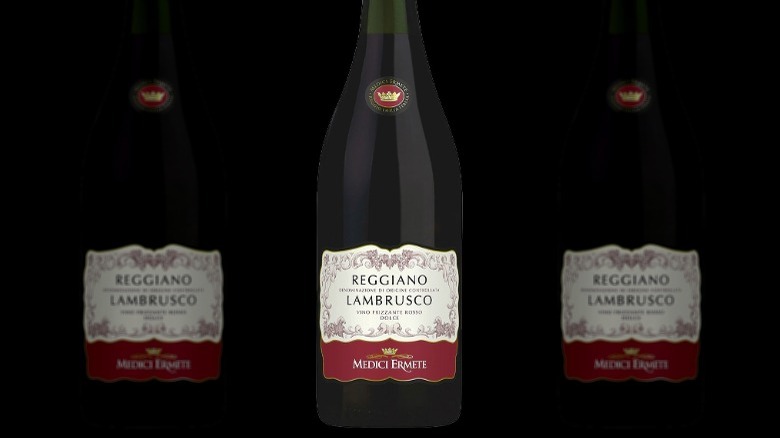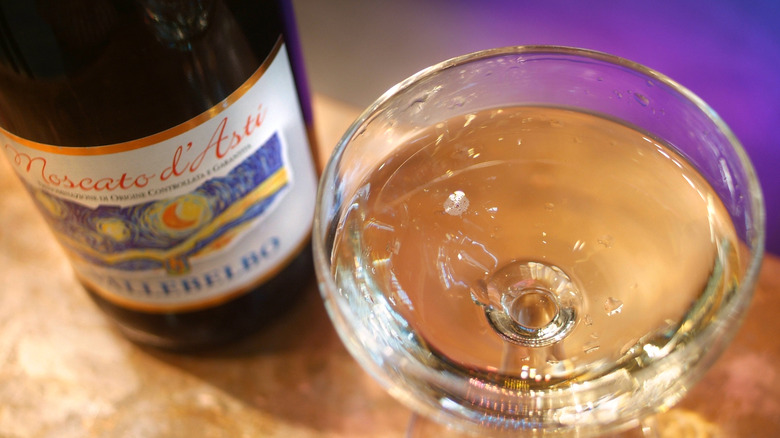13 Types Of Dessert Wine, Explained
The sweet wine category is in serious need of a rebrand. Whether it's a product of low-carb diet trends or its association with cheap wines that are loaded with sugar to mask unsavory flavors, it's time to reconsider. Dessert wines are made in a wide range of styles worldwide, with different grape varieties and sweetness levels. Some undergo fortification, others are made with dried grapes, and yet others are the product of noble rot or freezing temperatures. While you may notice dessert wines tend to garner a higher price tag, keep in mind that their sweetness typically precludes you from sipping on multiple glasses.
Unless your sweet tooth meter is at a complete zero, chances are you enjoy a sweet treat now and again. Whether you choose to serve these dessert wines in lieu of food or find the perfect pairing to go with your homemade pastries, this list will be of service. We've breaking down the top popular dessert wines to help you narrow down the selection at the liquor store.
Vin santo
There's certainly something saintly about vin santo, and it might be the painstaking process required to pull off this sweet wine with ties to Tuscany. Typically produced from trebbiano Toscano or malvasia bianca lunga (or a blend), vin santo occasionally comes in a red hue courtesy of sangiovese. But what really sets this style apart from the masses is its production method known as appassimento. After harvest, ripe grapes are spread out on straw mats or racks in ventilated rooms for a few months. The result is dried fruit with concentrated sugar levels and aromatics. At this point, the fruit is pressed for its juice and it undergoes a slow fermentation followed by a minimum of a few years of aging to build up layers of flavor.
While some styles are vinified dry, arguably the best vin santo is rich and unctuous in its sweetness. Traditionally, the wine is enjoyed by dipping cantucci (small almond biscotti) in the glass. (Of course, if you're really looking to experience the wine at its purest, you'll want to refrain from tainting it with dry crumbs.) Sample a rare bottle of red vin santo occhio di pernice by San Lorenzo A Bibbiano made with sangiovese grapes. For a classic white style, Domini Castellare di Castellina vin santo S. Niccolò is a great choice, with notes of dried and candied fruits and caramel on the palate.
Madeira
This lesser-known fortified Portuguese dessert wine deserves just as much shelf space as Port. Over 500 years ago Madeira was being shipped from its namesake island to England, where it was popular among the royal class. Unique to Madeira's winemaking process is a heating step, which originally occurred as a byproduct of the wine's long sea voyage. Nowadays, the method is deliberate and entails heating the tanks either directly or by storing them in a warm environment. This results in novel flavors and aromas and has the benefit of partly oxidizing the wine to preserve it near-endlessly.
Madeira is primarily made with local white wine grapes, which dictate the final style. From light and dry to rich luscious dessert wines, there's something for everyone. On the sweeter end of the spectrum, look for bual (boal) or malmsey (malvasia) on the label. These grapes produce deep and complex aromas, with the flavor profile to match. The dried raisin and caramel notes make these an excellent pairing for chocolate, fruit, and coffee-based desserts, or a hard cheese.
Blandy's has been making Madeira for over 200 years and it boasts the quality to match its lengthy experience. For a solid introduction, snag yourself a bottle of the label's 5 year old Bual, which offers warm aromas of vanilla, toffee, and dried fruit. Move further down the sweetness scale with Barbeito's Malvasia Old Reserve 10 year old, which retains elegance and freshness amidst the rich nutty notes.
Sherry
Sherry is no longer delegated as just a cooking wine to keep on hand in your fridge. Dry Fino styles are increasingly being served in trendy bars, but it's the sweet ones that make such a great pairing with your dessert course. Pedro Ximénez (aka PX) and Moscatel are both naturally sweet styles of Sherry, each named for the primary grape used.
PX is made by sun-drying grapes until the sugars and aromas become highly concentrated, making it one of the sweetest wines on the market. Thankfully, that intensity is balanced by a fresh acidity that complements the quasi-syrup-like nature of the wine. Dried raisins, figs, and dates all stand out, along with spices, and chocolatey aromas. It's no surprise that a classic way to serve PX is drizzled atop vanilla ice cream. Moscatel Sherry is on the fruitier end of the spectrum with floral notes and a slightly drier finish. The tamer sweetness makes it a pleasant pairing with lighter fruit-based desserts.
Try a bottle of Nectar PX by Gonzalez Byass, brimming with notes of dried fruits and syrup, with a lengthy caramel-tinged finish. For candied aromas and hints of nuttiness, look no further than Bodegas Dios Baco's Esnobista Moscatel Pasa.
Recioto della Valpolicella
As is immediately clear when chewing on a raisin, drying fruit intensifies the sweetness. The sugar becomes more concentrated as the water evaporates, leaving enhanced flavors behind. The Valpolicella region in Italy is known for its pleasant red wines and bold Amarone, but there's more to it. As one of the world's oldest wines, Recioto della Valpolicella is made by drying local red grapes (typically a blend) on straw mats or racks.
Instead of fermenting the wine until all the sugar has been consumed by yeast, Recioto's production is halted to retain sweetness. The result is decadent with ripe flavors of dark fruits and berries on the palate. Although it is undeniably rich, this dessert wine is far from cloying. The complex fruit aromas make it a fantastic pairing with chocolate-based desserts as well as with treats that incorporate nuts, dried fruit, and coffee. Sip on this ancient wine with a bottle by Albino Armani, rich with dark fruits and cacao aromas.
Vin Doux Naturel
The South of France might be most famous for its rosé wines, but sooner or later the secret about vin doux naturel will be out. These naturally sweet wines are fortified in order to halt the fermentation, resulting in notable levels of residual sugar. Several smaller designations in the region produce the style, each with selected grape varieties and regulations.
The Banyuls AOC receives plenty of glory, thanks to the rich flavors of the primary grape, grenache. Depending on its aging regimen, the wine offers more fruit-forward aromas or a nuttier profile. Furthermore, it's commonly stored in direct sun to evoke particular qualities. M. Chapoutier is an esteemed producer and wine merchant in the region. Serve a bottle of Banyuls with a decadent slice of chocolate cake to bring out the cocoa and dark fruit aromas in the wine.
Other vin doux naturel regions include Maury, Rivesaltes, and Rasteau. We're particular fans of Muscat de Beaumes de Venise, a floral style made with white muscat grapes. Notes of tropical fruit lead the way to dried fruits and honey over time. Pour a glass by Domaine des Bernardins and enjoy the rose and stone fruit essence solo as an aperitif. Alternatively, serve it with a cheese course and fruity or nutty desserts.
Sweet rieslings
Riesling is often misconstrued as always being sweet, and we're going to perpetuate that myth a bit longer. Part of what makes the varietal an excellent candidate for dessert wines is its searing acidity. Minus the sugar, it's best left to people who enjoy tart tastes, but it's all balanced with sweetness.
Riesling is grown worldwide but its home is Germany, where the grape is grown on a wide range of soils in numerous styles, truly marking its territory. Unless it is labeled as "trocken" (dry), you can guarantee some degree of perceptible sweetness. Since German bottle labels are notoriously hard to read, it's worth keeping a few terms in mind. From driest to sweetest, look for spätlese, auslese, beerenauslese, trockenbeerenauslese, and eiswein.
The latter three are especially sweet and made from grapes with particular attributes. Beerenauslese refers to grapes with noble rot, and trockenbeerenauslese is produced with grapes that dry on the vine prior to harvest. Finally, eiswein is German icewine and must be made from grapes that are frozen on the vine. Each offers layers of aromas that set it apart from the rest, but riesling's underlining features are present in all; aromas of green apple, lime, white flowers, and jasmine mingle in the glass. Another plus: Riesling can be stored for longer than most other white wines.
Considering the arduous hands-on nature of the harvest, these wines are typically pricey. Try Dr. Loosen's estate riesling beerenauslese for a rich and honeyed wine with luscious ripe fruit aromas. Or, try the winery's eiswein for a vibrant example of the style.
Icewine
As Canada's (and really Germany's) claim to fame, icewine is a frosty treat that owes its production to below-freezing temperatures. True icewine grapes are naturally frozen, sitting on vines late into the winter before harvest. Considering the numerous factors that can contribute to reduced yields (birds, pests, rot, disease, etc.), it tends to be pricey — and rightfully so. A 375-ml bottle the standard size for this elixir) requires over 6 pounds of grape to produce. When you compare that with about 2½ pounds of fruit to make a 750-ml bottle of regular wine, the cost is a no-brainer.
Splurging on icewine is a delicious way to toast a special occasion as you marvel at the vast world of winemaking. Various grapes are used to produce the sweet wine, including riesling, cabernet franc, muscat, and a hybrid variety called vidal. While the late harvest date results in plenty of residual sugar, a naturally high acidity keeps it fresh and lively on the palate.
Wrapping up a gourmet dinner with a small glass of icewine is sure to satisfy your sweet tooth. Or, serve it with chocolate, fruit, or cream-based desserts to enhance the experience. While dessert wine implies a particular course, you'll want to experiment with icewine as an aperitif or pairing for a spicy dish too. Our recommendations: a bottle of Inniskillin vidal icewine from Ontario, Canada, or enjoy the red hybrid variety chambourcin from Johnson Estate Winery in New York.
Vouvray demi-sec
While we love a crisp refreshing glass of bubbles with zero perceptible residual sugar, there are occasions that call for the sweet stuff. Champagne and Prosecco are easily the most famous types of sparkling wine around, but it's worth stepping outside the box — especially when it comes to sweet styles. Vouvray is a multifaceted appellation from France's Loire Valley. The regional wines are made with the chenin blanc grape and come in still and sparkling styles that range from bracingly dry to lusciously sweet.
Chenin is a delightfully nuanced variety that simultaneously showcases a sharp acidity alongside tropical and stone fruit notes. Floral aromas and minerality contrast in this ever-evolving grape. Seek out bottles labeled Vouvray demi-sec for a sweet and sparkling version of this iconic wine. Whether you're looking for a sweet start to the night or to finish it off with effervescence, this wine fits the bill. Sip on it solo or pair it with soft cheeses, nuts, or fruit-based desserts. Pick up a bottle of De Chanceny Vouvray demi-sec Excellence for a pleasant balance of ripe fruits, honeyed aromas, and a stony finish.
Tokaji Aszú
Noble rot is a key feature of Tokaji aszú — in fact, the wine's name stems from its origin (Tokaj) and the Hungarian word for botrytis grapes (aszú). Its noble features are appropriate, as Louis XV supposedly deemed it to be "the king of wines and wine of kings." Shriveled grapes are hand-picked one by one, resulting in a very labor-intensive product worth every penny. Unlike some botrytis wines which solely include these grapes, Tokaji aszú is a blend of a base wine with the aszú grapes. Although it is undeniably sweet, it retains a balanced acidity that makes it surprisingly refreshing.
Furmint is the local grape variety typically used, but others like muscat and hárslevelű infuse the wine with fruity and floral aromas. Serve this complex wine with fruity desserts to extract more of the tropical notes from the glass. Alternatively, its acidity makes it a suitable pairing for light cheeses or blue varieties. Some wines are further aged in oak barrels, adding vanilla, caramel, and coconut aromas to the palate. Pick up some fine examples of Tokaji aszú by Disznókő or Château Megyer to discover notes of stone and tropical fruits and hints of spice in every sip.
Tawny Port
When dessert rolls around, it's not unusual for a bottle of Port to make its way to the table. While the category is widely recognized, it offers plenty of options to choose from. Tawny Port is a unique style that will quickly enhance your post-dinner experience. Made from a blend of Portuguese red grapes, each type of Port follows a different aging regimen. In the case of Tawny, that includes a minimum of time spent in oak, ultimately producing the brownish-golden color that gives it its name.
The rich mouthfeel showcases nutty aromas, with caramel, vanilla, and dried fruits on the palate. You'll definitely want to bake some nut-based treats to serve alongside this complex wine. Or, complement the caramelized flavors with a crème brûlée or cinnamon-infused apple pie. And if you're looking for a savory contrast, serve it with a hard cheese like cheddar or manchego.
Pick up a bottle of Croft Reserve Tawny and enjoy the spiced nuances blending with the fruit. If you want to take your love for the amber elixir a little further, Cockburn's 20 year old Tawny is a great option, brimming with notes of vanilla and baking spices. Of course, there's always a limited edition Taylor Fladgate's Golden Age 50 year old Port if you're celebrating.
Lambrusco
The fact that red sparkling wines get minimal shelf space at the average wine shop is not an indication of their qualities. We'd argue that the rarity adds to their appeal, but there are far more reasons to seek out a bottle on your next shopping trip. Lambrusco comes in various styles from sweet to dry and lightly effervescent to sparkling, all made with local grapes (variations on the Lambrusco name) from the Emilia Romagna province in Italy.
Although less-than-stellar versions from the '70s and '80s gave the wine a questionable reputation, it's time to let go of the past. Look for the word "dolce" on bottle labels as a clue that the contents are sweet, "amabile" for a semi-dry option, and skip over any that say "secco" if you're looking for a dessert wine.
Explore the wonderful world of Lambrusco with a bottle of Reggiano Medici sweet by Medici Ermete which offers notable violet aromas and red fruit undertones. Serve it with fruity desserts or sip on it solo to experience the wine to its fullest.
Sauternes
Named after the tiny region in Bordeaux, France where two rivers meet to produce optimal conditions, Sauternes is one of a kind. Loved by collectors and sweet wine drinkers alike, this luscious dessert sipper owes its flavors to noble rot, aka botrytis. While that may not be the adjective you most closely associate with mold, it turns out that in this case it really does work its magic. The combination of morning fog and warm afternoon sun sets botrytis apart from the type of mold that will make winemakers pull out their hair.
Sauternes is primarily made with sauvignon blanc and sémillon grapes, with small amounts of sauvignon gris and muscadelle in some blends. As the grapes hang on the vines late into the season, noble rot concentrates the flavors, intensifying the aromas and highlighting them with a streak of acidity. Honeyed notes mingle with tropical fruits, caramel, coconut, and a hint of baking spices. The result is wonderfully balanced and suitable to pair with fruit-based desserts, soft cheeses, and foie gras.
You'll want to shell out for a bottle of Château d'Yquem, which is in a league of its own as the only winery classified as a prestigious Premier Cru Superieur. For something more modest, Clos Haut-Peyraguey and Château Suduiraut have the tradition, reputation, and excellent vineyard locations backing them up. Drink them young or age them for a whole new bouquet of flavors.
Asti wines
A lot of people are introduced to the world of wine with a bottle of Moscato d'Asti. While we can't make the argument that every option on the market is stellar, the sweet and lightly effervescent wine is certainly worth seeking out. The halted fermentation means the result is naturally sweet and low in alcohol. It's no surprise that it is perfectly suited to take you from brunch to dessert pairings by way of aperitif hour.
Meanwhile, if you're looking for something a little more serious, Asti spumante is it. Also produced from perfumed moscato grapes, this wine showcases fine bubbles that give it an added layer of elegance. The alcohol content is more in line with table wine, yet this sweet wine retains a delicate quality. The decidedly floral aromatics and fruit-forward notes make both wines a winner with fruity desserts and soft creamy cheeses alike. Or, serve them with a spicy dish to tame the heat.
Pick up a bottle of Vietti Moscato d'Asti for a quality option that will make you forget about all the rest. If you're in the mood for something with more of a kick, Bartenura Asti is a reliable choice.
